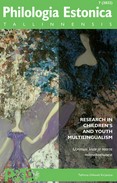EESTI KEELT TEISE KEELENA OMANDAVATE LASTE EESTI KEELE OSKUSE ARENG AASTA JOOKSUL
CHILDREN’S ESTONIAN AS A SECOND LANGUAGE DEVELOPMENT DURING A YEAR
Author(s): Piret Baird, Reili Argus, Merilyn MeristoSubject(s): Foreign languages learning, Language acquisition, Cognitive linguistics, Finno-Ugrian studies, School education, Pedagogy
Published by: Tallinna Ülikooli Kirjastus
Keywords: Estonian as a second language acquisition; an evaluation tool for language development; bilingualism; pre-A1 language level;
Summary/Abstract: Estonia is currently in the process of transitioning the education system to Estonian as the sole medium of instruction. Several pilot projects with the aim to support Estonian language learning in day nurseries and upper secondary schools have been started. However, there is not much empirical data on how Estonian as a second language acquisition takes place: which categories are acquired in which order, what kind of role input and age of onset play in the acquisition process. There is no research that would cover learning Estonian as a second language during a certain time period in a child’s development from the point of view of language categories and forms. Also, no methodology has been tested for studying and assessing the grammar skills of children. In SLA studies (De Wilde et al. 2021; Jia, Fuse, 2007; Unsworth et al. 2014) it has been found that the more a student receives input (also cumulatively) the more successful he/she will be. De Wilde et al. (2021) have found that in addition to traditional language classes primary school children also need contextual contact with the language. Language learning is more successful if the child has other opportunities besides the language class to speak the target language. The amount and frequency of contact with the language are important in vocabulary learning (N. Ellis 2002; Puimege, Peters 2019). Hearing the L2 often also supports the acquisition of grammar forms (van Zeeland, Schmitt 2013). Contextual language learning is of great importance, especially in the acquisition of verbs because they need a situative environment (Puimege, Peters 2019).
Journal: Philologia Estonica Tallinnensis
- Issue Year: 7/2022
- Issue No: 1
- Page Range: 39-79
- Page Count: 41
- Language: Estonian

